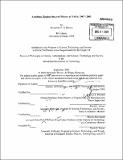Accidents, engineering and history at NASA: 1967-2003
Author(s)
Brown, Alexander F. G. (Alexander Frederic Garder), 1970-
DownloadFull printable version (31.95Mb)
Other Contributors
Massachusetts Institute of Technology. Program in Science, Technology and Society.
Advisor
David A. Mindell.
Terms of use
Metadata
Show full item recordAbstract
The manned spaceflight program of the National Aeronautics and Space Administration (NASA) has suffered three fatal accidents: one in the Apollo program and two in the Space Transportation System (the Shuttle). These were the fatal fire in Apollo 204 (Apollo 1) in 1967, the explosion of the Solid Rocket Booster in STS-51L (Challenger) in 1986, and the destruction of the orbiter in STS-107 (Columbia). Three astronauts lost their lives in 1967, and in each Shuttle accident seven astronauts were killed. Following each of these fatal accidents, a significant investigation was conducted and a comprehensive investigation report produced. These investigation reports each served to create public narratives of the reasons for the accidents. The reports shaped the accidents' legacies for the space program and for large-scale complex engineering projects more generally. This thesis re-examines the evidence produced to investigate and explain each accident. By analyzing the investigation reports critically, as well as reviewing the accidents themselves, this work considers how engineering cultures and practices at NASA shifted to meet the changing demands of the space program. It argues that the public narratives of the accidents are not completely congruent with the engineering evidence, and that these very selective narratives are influential in shaping future strengths (and weaknesses) at NASA. By re-examining the accident evidence, the reports, and the role of each accident in shaping NASA engineering cultures, the thesis provides a view of engineering very different from what is apparent in previous historical work on the space program.
Description
Thesis (Ph. D. in History, Anthropology, and Science, Technology and Society (HASTS))--Massachusetts Institute of Technology, Program in Science, Technology and Society, 2009. Cataloged from PDF version of thesis. Includes bibliographical references (p. 293-320).
Date issued
2009Department
Massachusetts Institute of Technology. Program in Science, Technology and SocietyPublisher
Massachusetts Institute of Technology
Keywords
Program in Science, Technology and Society.